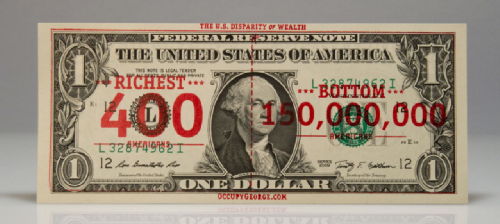All entries for Wednesday 13 August 2014
August 13, 2014
Disobedient Objects, Roman Coins and the Battle of Teutoberg Forest
 |
| US $1 bill, defaced by an ink stamp. From occupygeorge.com |
Included the Disobedient Objects exhibition currently at the V & A are a series of defaced monetary items, including the US dollar bill above. As material representations of a particular ruling authority that permeate our daily lives, currencies are often used to express dissatisfaction with governmental authorities, or even rebellion. A similar practice also occured in the Roman Empire, when the vast majority of circulating coinage carried the portrait of the emperor, an image that had strong power and charisma. In Roman culture it was vitally important to be remembered after one's death through one's actions and monuments; to destroy a monument or a portrait, then, was to attack the person's very being. (This Roman practice of destroying or defacing an image, whether material or literary, is called damnatio memoriae in modern scholarship).
We find numerous instances of coin mutilation and defacement in the Roman world: coins being slashed, stabbed, subject to graffiti, cut and pierced. If there is no archaeological context, it is difficult to know the motivations behind these actions. In some instances, a coin would be mutilated before being given as an offering to a deity (ensuring that the coin could never again be used for 'profane' commercial transactions, it would always belong to the god or goddess). We do not know the motivations behind the mutilation of the coin below, for example, recently found in Hertfordshire in Britain, and registered on the Portable Antiquities Scheme. But a well-known and clear example of politically motivated currency mutilation can be found at the archaeological site of Kalkriese.
 |
| Mutilated Roman Coin. (PAS BH-57-3B8). |
The site of Kalkriese was the site of a battle between Roman and German forces in the early first century AD. Though not universally accepted, many identify the site as the location of the Battle of Teutoberg Forest, in which the Roman general Varus was horribly defeated by the Germans in AD 9, losing several legions and cohorts. Amongst the finds on this ancient battlefield are numerous coins, with a large number of Augustan small bronze coins (called asses) from the mint at Lugdunum (Lyons). A significant proportion of these asses were defaced by stabbing, cuts or slashes. The original publication of these coins argued that these actions were performed by dissatisfied Roman troops (Berger). More recently, Kemmers and Myberg have suggested that the Germans may have been responsible: after defeating the Romans, the Germans then went on to deface one of the most potent symbols of Roman imperial power. Interpretation remains open, but the finds indicate that the coins must have been carried onto battlefield by the Romans. In this case it is perhaps unlikely that Roman troops were responsible for the mutilation - after the defacement the coins would no longer have been considered valid currency and there would be little reason for a Roman to be carrying them around, particularly into battle. The mutilation might thus have occured as part of the German post-battle victory celebrations.
For more on the defaced currrencies currently on display in London see this post. For the coins at Kalkriese see F. Berger, (1996). Kalkriese 1: Die römische Fundmünzen. Mainz; and F. Kemmers, F. and N. Myberg (2011). "Rethinking numismatics. The archaeology of coins." Archaeological Dialogues 18: 87-108.
 Clare Rowan
Clare Rowan

 Please wait - comments are loading
Please wait - comments are loading

 Loading…
Loading…